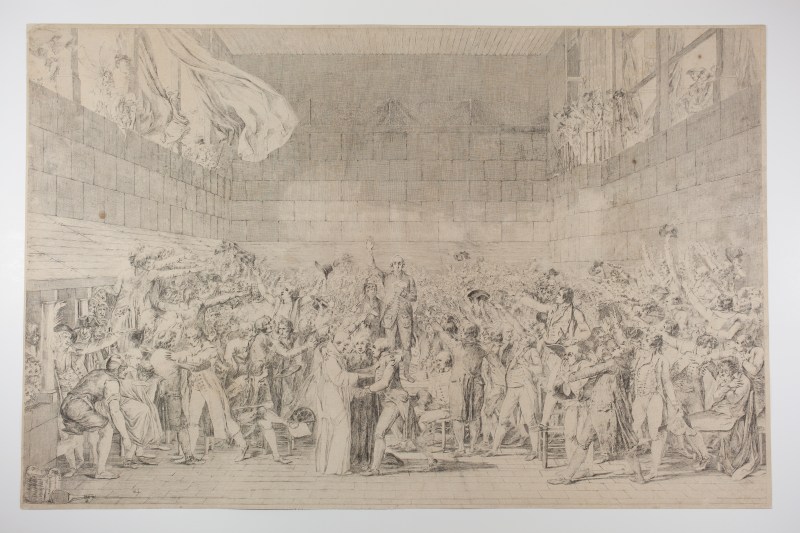Dominique-Vivant DENON in collaboration with Jacques-Louis DAVID : Le Serment du Jeu de Paume - 1793/1794
SOLD
Etching, 490 x 759 mm (borderline), 500 x 766 mm (sheet). IFF 405; Bordes B1; Denon: L'oeil de Napoléon no. 55.
Marcel Roux in the Inventaire du Fonds Français states that this print has no lettering, which is reiterated by Philippe Bordes. This is inaccurate, as Udolpho van de Sandt points out in Denon: L'oeil de Napoléon: it is signed and dated in drypoint, admittedly very light and very difficult to read. Udolpho van de Sandt writes: "Signed, dated, bottom left: David faciebat 1791; bottom right: Denon scul anno 3". For our part, we read instead the following letter, entirely written in the lower right-hand corner of the composition: J L [?] David faciebat an° 1791 Denon scul anno 2.
Very fine impression printed on watermarked laid paper (double-headed eagle bearing a heart surmounted by a crown and AUVERGNE cartouche accompanied by names that are difficult to read). Good condition. Sheet slightly yellowed; three small foxmarks in the subject; a trace of vertical rubbing at the top; a 40 mm tear restored on the right edge; the extreme tip of the upper left corner repaired in the white part (no lack in the image); three tiny abrasions. Verso: trace of a vertical central fold and trace of a diagonal fold.
Impressions of this unfinished plate are extremely rare: we know of only three others. The Bibliothèque nationale de France owns two. One (object number RESERVE AA-5 (DENON, Dominique-Vivant), former object number EF-47-FOL), has been digitised and is available online: ESTNUM-31225; it comes from the collection of Dominique-Vivant Denon. It is trimmed to around 1 cm outside the square line. The other impression in the BnF (RESERVE AA-6, ESTNUM-23609 (microform)) is reproduced in Dominique-Vivant Denon: l'œil de Napoléon. A third impression is in the British Museum (object number 1878,0713.2079).
Exhibition: Our impression was exhibited at the Palais Bourbon in 1989 as part of the exhibition celebrating the bicentenary of the French Revolution and the National Assembly. It is reproduced in the catalogue 1789, L'Assemblée nationale, page 95 (detail), and described on p. 123.
In 1790 David conceived the project of painting a very large picture commemorating the Oath of the Jeu de Paume, the term used to describe the commitment made on 20 June 1789 by the 576 deputies assembled in the Salle du Jeu de Paume in Versailles to meet until a new Constitution was established. A public subscription was soon launched to raise the funds needed for this monumental painting. In May 1791, a large preparatory drawing in graphite, ink, bistre wash and white highlights (65 x 105 cm) was completed by David and presented in his studio in the Louvre. It was then exhibited at the Salon of September 1791 with the following note: "On souscrit pour la gravure de ce dessin chez M. Gerdret, négociant, rue des Bourdonnais". However, the subscription was not as successful as had been hoped. The political uncertainties linked to the Terreur forced David to abandon his painting for the time being.
The project was not completely abandoned, however, and in early 1794 Dominique-Vivant Denon collaborated with David to produce an etching of the Serment. At this time, the painter "sent a note to the Minister of Foreign Affairs to defend the printmaker, who was suspected of incivism because of his stays abroad: '[...] We are currently working jointly on the etching of the Jeu de Paume painting. He did the etching; he would not have done it if he had not been a good patriot'" (Bordes, p. 85, translated by us).
However, the print itself remained unfinished. "In a note, the date and addressee of which are not known, Denon complained that the work on the large etching was too extensive "to bring it to its final effect, if he did it alone" and wished to have "a collaborator who would take care of the reworking with burin and drypoint". Nonetheless, Denon's work, with its untidy graphic style and lack of concern for rendering the portraits, which suits the political ambiguity of the project very well, is admirable and possesses an energy of execution that we look for in vain in the prints that Jazet would produce thirty years later". (Bordes, p. 85, translated by us).
In exile in Brussels, in 1820 David gave the right to engrave the Serment du Jeu de Paume to the Parisian Daniel Isoard de Martouret, who hired Jean-Pierre-Marie Jazet in 1821 to prepare the print, which was completed and marketed a few years later.
References: Philippe Bordes: Le Serment du Jeu de Paume de Jacques-Louis David: le peintre, son milieu et son temps, de 1789 à 1792. Notes et documents des musées de France 8. Paris: Éditions de la Réunion des musées nationaux, 1983. Marie-Anne Dupuy (ed.): Dominique-Vivant Denon: l'œil de Napoléon: Paris,



